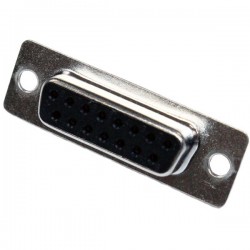D TYPE SOLDER PLUG AND SOCKET TURNED PIN
The D-sub series of connectors was introduced by ITT Cannon in 1952.Cannon's part-numbering system uses D as the prefix for the whole series, followed by one of A, B, C, D, or E denoting the shell size, followed by the number of pins or sockets, followed by either P (male) or S (female) denoting the gender of the parts. Each shell size usually corresponds to a certain number of pins or sockets: The contacts in each row of these connectors are spaced 326/3000 of an inch apart, or approximately 0.1087 inches (2.76 mm), and the rows are spaced 0.112 inches (2.84 mm) apart. The pins in the two rows are offset by half the distance between adjacent contacts in a row. This spacing is called standard density. The suffixes M and F (for male and female) are sometimes used instead of the original P and S for plug and socket.
Later D-sub connectors added extra pins to the original shell sizes, and their names follow the same pattern. For example, the DE-15, usually found in VGA cables, has 15 pins in three rows, all surrounded by an E size shell. The pins are spaced at 0.090 inches (2.3 mm) horizontally and 0.078 inches (2.0 mm) vertically, in what is called high density. The other connectors with the same pin spacing are the DA-26, DB-44, DC-62, DD-78 and DF-104. They all have three rows of pins, except the DD-78 which has four, and the DF-104 which has five rows in a new, larger shell. The double density series of D-sub connectors have even denser configurations and consists of the DE-19, DA-31, DB-52, DC-79, and DD-100. These each have three rows of pins, except the DD-100, which has four.
Model: DM15SP
DM15SP 15 WAY D SUB PLUG WITH MACHINED CONTACTS.
BLACK GLASS FILLED POLYESTER INSULATER TO UL94 V-0
THE SHELL IS STAMPED STEEL WITH TIN PLATE
THE CONTACTS ARE COPPER ALLOY MACHINED PINS WITH 500 INSERTS MINIMUM AND ARE SELECTIVE PLATED GOLD OVER NICKEL.
DOWNLOAD DATASHEET&n..
£2.52
Ex Tax:£2.10
Model: DM15SS
DM15SS 15 WAY D SUB SOCKET WITH MACHINED CONTACTS.BLACK GLASS FILLED POLYESTER INSULATER TO UL94 V-0
THE SHELL IS STAMPED STEEL WITH TIN PLATE
THE CONTACTS ARE COPPER ALLOY MACHINED PINS WITH 500 INSERTS MINIMUM AND ARE SELECTIVE PLATED GOLD OVER NICKEL.
DOWNLOAD DATASHEE..
£3.00
Ex Tax:£2.50
Model: DM25SP
DM25SP 25 WAY D SUB PLUG WITH MACHINED CONTACTS.
BLACK GLASS FILLED POLYESTER INSULATER TO UL94 V-0
THE SHELL IS STAMPED STEEL WITH TIN PLATE
THE CONTACTS ARE COPPER ALLOY MACHINED PINS WITH 500 INSERTS MINIMUM AND ARE SELECTIVE PLATED GOLD OVER NICKEL.
DOWNLOAD DATASHEET&..
£4.44
Ex Tax:£3.70
Model: DM25SS
DM25SS 25 WAY D SUB SOCKET WITH MACHINED CONTACTS.BLACK GLASS FILLED POLYESTER INSULATER TO UL94 V-0
THE SHELL IS STAMPED STEEL WITH TIN PLATE
THE CONTACTS ARE COPPER ALLOY MACHINED PINS WITH 500 INSERTS MINIMUM AND ARE SELECTIVE PLATED GOLD OVER NICKEL.
DOWNLOAD DATASHEE..
£5.45
Ex Tax:£4.54
Model: DM37SP
DM37SP 37 WAY D SUB PLUG WITH MACHINED CONTACTS.
BLACK GLASS FILLED POLYESTER INSULATER TO UL94 V-0
THE SHELL IS STAMPED STEEL WITH TIN PLATE
THE CONTACTS ARE COPPER ALLOY MACHINED PINS WITH 500 INSERTS MINIMUM AND ARE SELECTIVE PLATED GOLD OVER NICKEL.
DOWNLOAD DATASHEET&nbs..
£7.15
Ex Tax:£5.96
Model: DM37SS
DM37SS 37 WAY D SUB SOCKET WITH MACHINED CONTACTS.BLACK GLASS FILLED POLYESTER INSULATER TO UL94 V-0
THE SHELL IS STAMPED STEEL WITH TIN PLATE
THE CONTACTS ARE COPPER ALLOY MACHINED PINS WITH 500 INSERTS MINIMUM AND ARE SELECTIVE PLATED GOLD OVER NICKEL.
DOWNLOAD DATASHEE..
£8.69
Ex Tax:£7.24
Model: DM9SP
9 WAY D SUB PLUG WITH MACHINED CONTACTS.
BLACK GLASS FILLED POLYESTER INSULATER TO UL94 V-0
THE SHELL IS STAMPED STEEL WITH TIN PLATE
THE CONTACTS ARE COPPER ALLOY MACHINED PINS WITH 500 INSERTS MINIMUM AND ARE SELECTIVE PLATED GOLD OVER NICKEL.
DOWNLOAD DATASHEET ..
£1.66
Ex Tax:£1.38
Model: DM9SS
9 WAY D SUB SOCKET WITH MACHINED CONTACTS.BLACK GLASS FILLED POLYESTER INSULATER TO UL94 V-0THE SHELL IS STAMPED STEEL WITH TIN PLATETHE CONTACTS ARE COPPER ALLOY MACHINED PINS WITH 500 INSERTS MINIMUM AND ARE SELECTIVE PLATED GOLD OVER NICKEL. DOWNLOAD DATASHEET..
£2.26
Ex Tax:£1.88Showing 1 to 8 of 8 (1 Pages)









-1140x300w.jpg)


































